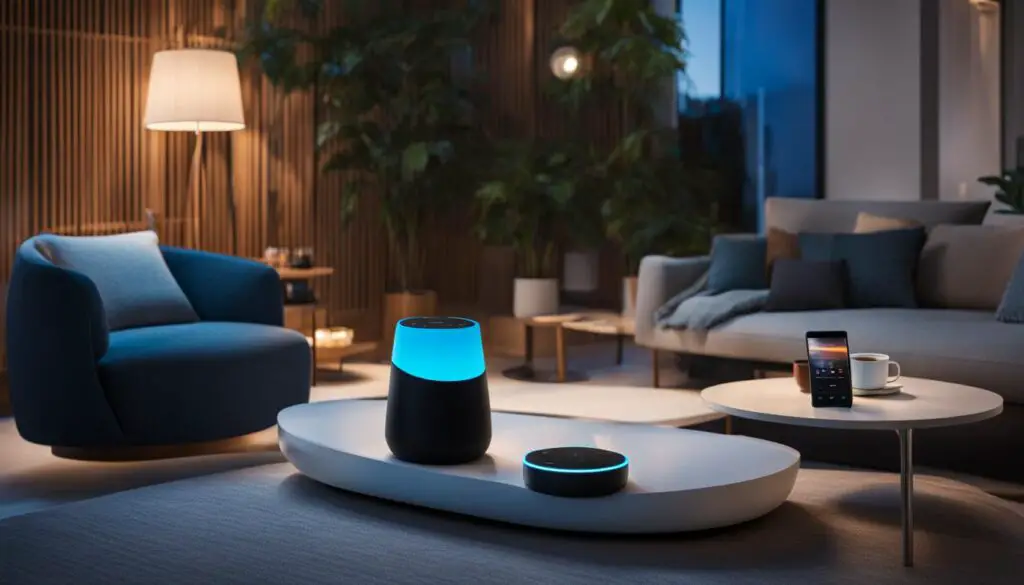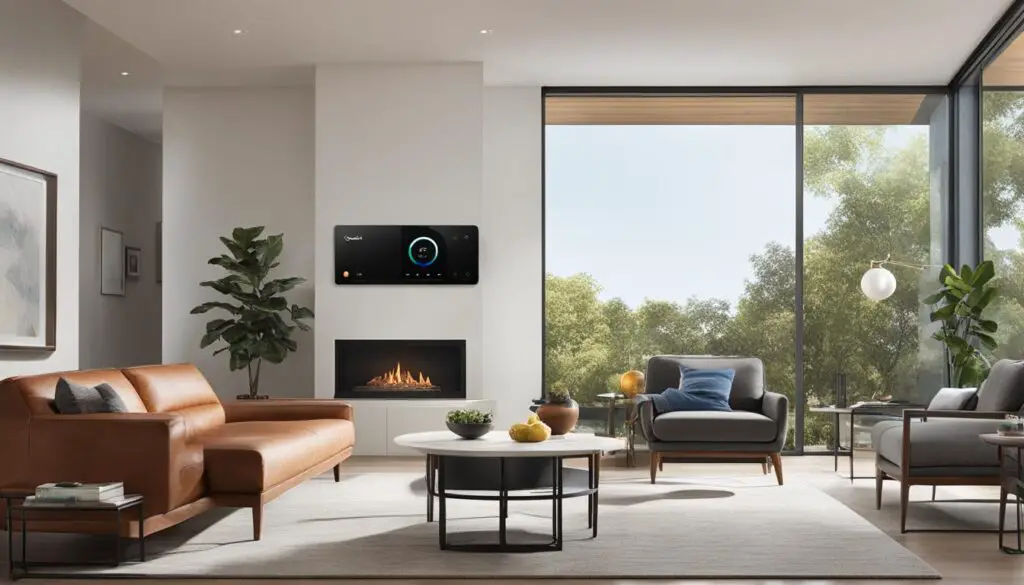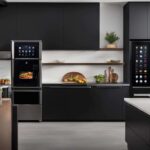When it comes to creating a smart and connected home, choosing the right home automation system is crucial. With the countless options available on the market, finding the best fit for your needs can be overwhelming. That’s why I’ve compiled this comprehensive guide to compare the top home automation systems of 2023, helping you make an informed decision.
In this guide, I will evaluate the features, compatibility, and user experience of the most popular home automation systems, including Amazon Alexa, Google Nest, Samsung SmartThings, Apple HomeKit, and Amazon Echo. By delving into their strengths and weaknesses, you’ll gain valuable insights into which system aligns best with your preferences.
Whether you’re looking for voice-controlled automation, seamless integration with other smart devices, or a user-friendly interface, this comparison guide will provide you with the information you need to select the best home automation system for your household.
Table of Contents
Key Takeaways:
- Evaluate the features, compatibility, and user experience of home automation systems before making a decision.
- Consider your personal preferences and needs when comparing systems such as Amazon Alexa, Google Nest, Samsung SmartThings, Apple HomeKit, and Amazon Echo.
- Look for seamless integration with other smart devices and user-friendly interfaces for a streamlined home automation experience.
- Voice-controlled automation and customization options are important factors to consider while choosing a home automation system.
- Make sure to prioritize data security and privacy features when selecting a home automation system.
Evaluating Amazon Alexa’s Features and Automation Power
As an Amazon Alexa user, I can attest to the impressive features and automation power that this popular home automation system offers. With its intuitive voice controls and extensive compatibility, Alexa provides a seamless smart home experience.
The Amazon Alexa app serves as a hub for managing and customizing your smart home devices. It allows for easy integration with a wide range of devices, such as smart lights, thermostats, security systems, and more. Once connected, you can control and monitor your entire smart home ecosystem through simple voice commands.
But it doesn’t stop there. Amazon Alexa’s automation capabilities take smart home convenience to the next level. With routines, you can create personalized automations to fit your lifestyle. Whether it’s turning off all the lights and locking the doors before bed or adjusting the temperature when you arrive home, Alexa can handle it all with a single command.
The Power of Amazon Alexa
“Alexa, turn on the living room lights.”
Amazon Alexa’s voice commands provide quick and effortless control over your smart home devices. From dimming the lights to adjusting the thermostat to streaming your favorite music, Alexa’s versatility is unmatched.
Furthermore, Alexa skills expand the functionality of your smart home devices. With a vast library of skills, you can do everything from ordering a pizza to checking the weather forecast utilizing voice commands.
To give you a better understanding of Amazon Alexa’s key features and automation power, take a look at the table below:
| Key Features | Automation Power |
|---|---|
| Intuitive voice controls | Customizable routines for personalized automations |
| Extensive device compatibility | Seamless integration with a variety of smart home devices |
| Wide range of available skills | Expands the functionality and capabilities of smart home devices |
With these powerful features and automation capabilities, Amazon Alexa firmly establishes itself as a top contender in the home automation market.

Whether you’re a tech enthusiast looking for a voice-controlled smart home or a homeowner seeking an efficient, hands-free lifestyle, Amazon Alexa has the features and power to transform your home into a fully automated haven.
Exploring Google Nest’s Integration and User-friendly Interface
When it comes to choosing a home automation system, Google Nest is a top contender in the market. Powered by Google Assistant, Google Nest offers a visually appealing and user-friendly interface for controlling smart home devices. With its seamless integration with Google services and personalized features, Google Nest is a strong choice for those already immersed in the Google ecosystem.
One of the standout features of Google Nest is its voice command functionality. Setting up and remembering voice commands is a breeze, allowing users to effortlessly control their smart devices with just a few words. Whether it’s adjusting the thermostat, turning off the lights, or playing music, Google Nest understands your commands and executes them seamlessly.
Google Nest also boasts a wide range of compatible devices from various home automation brands, ensuring that users have plenty of options to choose from when building their smart home ecosystem. From smart thermostats and security cameras to smart lighting and entertainment systems, Google Nest integrates effortlessly with a diverse range of devices.
The user interface of the Google Nest app is intuitive and easy to navigate, making it straightforward to set up and configure your smart home devices. With its clean design and well-organized menus, Google Nest offers a pleasant user experience that promotes ease of use and convenience.

The Benefits of Google Nest:
- Seamless integration with Google services
- Easy-to-use voice command functionality
- Wide range of compatible devices
- Intuitive and user-friendly interface
“Google Nest offers a visually appealing and user-friendly interface for controlling smart home devices.”
In summary, Google Nest is a smart choice for those who want a home automation system that seamlessly integrates with Google services and offers a user-friendly interface. With its extensive compatibility and personalized features, Google Nest provides a versatile solution for turning your house into a smart home.
| Pros of Google Nest | Cons of Google Nest |
|---|---|
| Seamless integration with Google services | Compatibility limited to Google ecosystem |
| Easy-to-use voice command functionality | Potential privacy concerns with data sharing |
| Wide range of compatible devices | May not have the same extensive third-party device support as other platforms |
| Intuitive and user-friendly interface | App customization options may be limited |
Understanding Samsung SmartThings’ Ease of Use and Customization Options
When it comes to home automation systems, Samsung SmartThings stands out for its user-friendly interface and versatile customization options. Whether you’re new to smart home technology or a seasoned enthusiast, SmartThings offers a seamless and straightforward experience.
One of the key advantages of Samsung SmartThings is its ease of use. The intuitive interface makes it easy to navigate through various settings and controls. Setting up devices and creating automation routines is a breeze, even for beginners.
Customization is another strength of SmartThings. The system offers both scheduled and reactive programming options, allowing users to tailor their automation based on their preferences and daily routines. This level of customization ensures that SmartThings adapts to your lifestyle.
“Samsung SmartThings provides a straightforward user interface that is ideal for beginners in the world of smart home systems.”
-Home Automation Enthusiast
SmartThings boasts a wide range of compatible devices, including lights, thermostats, locks, and more. This ensures that you can integrate numerous smart devices into your home automation setup. Whether you prefer Samsung’s own devices or other popular brands, SmartThings offers compatibility and versatility.
Furthermore, SmartThings supports IFTTT (If This Then That), allowing you to create customizations and automate interactions between different devices and services. This feature adds an extra layer of flexibility and control to your smart home setup.
Samsung SmartThings Home Automation System Cost Comparison:
Now, let’s take a look at the cost of the Samsung SmartThings home automation system compared to other popular options on the market:
| Home Automation System | Cost |
|---|---|
| Samsung SmartThings | Starting at $69.99 |
| Amazon Alexa | Starting at $24.99 |
| Google Nest | Starting at $99.99 |
| Apple HomeKit | Starting at $99.99 |
| Amazon Echo | Starting at $49.99 |
As you can see, Samsung SmartThings offers an affordable entry point into home automation, with starter kits available at competitive prices. This makes it an excellent choice for budget-conscious users who still want a powerful and customizable smart home system.
With its ease of use, customizable features, wide device compatibility, and affordable pricing, Samsung SmartThings is a solid contender in the home automation market. Whether you’re looking to enhance security, increase energy efficiency, or streamline everyday tasks, SmartThings has the tools to transform your home into a smart haven.
Exploring Apple HomeKit’s Seamless Integration and User-Friendly Design
When it comes to home automation brands, Apple HomeKit stands out for its seamless integration and user-friendly design. Designed specifically for iOS users, HomeKit prioritizes data security and privacy, aligning with Apple’s commitment to user protection.
With HomeKit, users can control and automate various smart devices in their homes, all from a central app. The visual interface of the HomeKit app is intuitive and easy to navigate, simplifying the setup process for automation routines. Whether it’s adjusting the lighting, controlling thermostats, or managing security cameras, HomeKit provides a cohesive and user-friendly experience.
However, it is worth noting that the compatibility of smart home automation devices with HomeKit may be more limited compared to other platforms. While HomeKit supports a wide range of devices, users should check the compatibility list to ensure their preferred devices can be integrated.
“Apple HomeKit offers a seamless integration and a user-friendly interface that aligns seamlessly with iOS devices.” – Home Automation Enthusiast
To provide a clearer understanding, here is a comparison table that summarizes the key features and limitations of Apple HomeKit:
| Features | Limited Compatibility |
|---|---|
| Seamless integration with iOS devices | Not all smart devices are HomeKit compatible |
| User-friendly visual interface | Requires compatible devices for full functionality |
| Strong emphasis on data security and privacy | May require additional setup for non-HomeKit devices |
Assessing Amazon Echo’s Voice Control and Smart Home Integration
When it comes to smart home automation, the Amazon Echo is a frontrunner in the market. Powered by Alexa, the Echo offers seamless voice control and integration with a wide range of smart devices. With just a simple voice command, you can control your lighting, adjust the thermostat, lock the doors, and even play your favorite music.
The Echo’s voice assistant capabilities provide convenient access to a plethora of commands and routines, making it effortless to manage your smart home. Whether you’re looking to create a morning routine that turns on the lights and brews your coffee or simply want to adjust the temperature from the comfort of your couch, the Echo has you covered.
One of the key strengths of the Amazon Echo is its vast compatibility and easy device integration. It works seamlessly with various brands and smart home technologies, allowing you to build a comprehensive and interconnected system to suit your needs. From smart lights and thermostats to security cameras and door locks, the Echo serves as a central hub for your smart home automation.
Home automation system cost is a crucial consideration for many homeowners. The Amazon Echo offers a range of options to fit different budgets, making it accessible to a wide audience. Whether you’re starting small with a single Echo device or expanding your smart home with multiple Echos in different rooms, you can find a configuration that suits your budget and requirements.
Eager to see how the Amazon Echo stacks up against other leading smart home systems in terms of voice control and integration? Take a look at the comprehensive table below for a comparison:
| Smart Home System | Voice Control Capabilities | Device Compatibility |
|---|---|---|
| Amazon Echo | ✓ | ✓ |
| Google Nest | ✓ | ✓ |
| Samsung SmartThings | ✓ | ✓ |
| Apple HomeKit | ✓ | ✓ |
* Key: ✓ Fully supported
As you can see, the Amazon Echo stands out with its voice control capabilities and extensive device compatibility, placing it among the top contenders in the smart home technology landscape.
Conclusion
In conclusion, when it comes to home automation, choosing the right system is crucial. By comparing the top home automation systems such as Amazon Alexa, Google Nest, Samsung SmartThings, Apple HomeKit, and Amazon Echo, individuals can gain valuable insights into their features, ease of use, and integration capabilities.
Factors such as compatibility, automation power, and user experience should be considered when selecting a home automation system.
Overall, the best home automation system is subjective and depends on individual preferences and needs. It is recommended that individuals refer to this comprehensive guide, along with their own research, to make an informed decision that aligns with their lifestyle and goals.
FAQ
What is a home automation system?
A home automation system is a network of smart devices and appliances that can be controlled and automated to enhance convenience, comfort, and energy efficiency in a home.
What are the benefits of a home automation system?
A home automation system offers several benefits, including increased convenience, energy savings, improved security, and the ability to monitor and control devices remotely.
Can I control my home automation system remotely?
Yes, most home automation systems allow remote control through smartphone apps or web interfaces, giving you the ability to monitor and control your devices from anywhere with an internet connection.
How do home automation systems work?
Home automation systems work by connecting different smart devices and appliances to a central hub or control system. This allows users to control and automate various functions and settings through a single interface.
Are home automation systems compatible with all devices?
Compatibility can vary depending on the system and the devices being used. It is important to check the compatibility of your devices with the chosen home automation system before making a purchase.
Can I integrate voice control with my home automation system?
Yes, many home automation systems offer voice control integration through popular voice assistants like Amazon Alexa, Google Assistant, or Apple Siri. This allows you to control your smart home devices using voice commands.
What is the cost of a home automation system?
The cost of a home automation system can vary depending on the system’s brand, features, and the number of devices you want to control. Basic systems may start around $200, while more advanced and comprehensive systems can cost upwards of $1000 or more.
Can I expand my home automation system in the future?
Yes, most home automation systems are designed to be expandable, allowing you to add more devices and functionalities as needed. It’s important to choose a system that offers a wide range of compatible devices and has a flexible architecture for future expansions.


